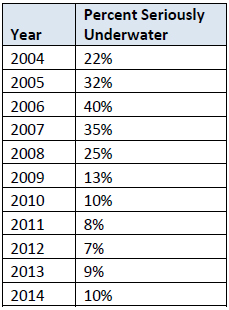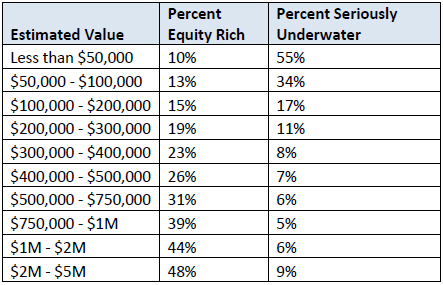The WPJ
THE WORLD PROPERTY JOURNALReal Estate Facts Not Fiction
Residential Real Estate News

8.1 Million U.S. Homes Have $1.4 Trillion in Negative Equity in Q3
Residential News » United States Edition | By Michael Gerrity | October 23, 2014 11:22 AM ET
According to RealtyTrac's U.S. Home Equity & Underwater Report for the third quarter of 2014, 8.1 million U.S. residential properties were seriously underwater -- where the combined loan amount secured by the property is at least 25 percent higher than the property's estimated market value -- representing 15 percent of all properties with a mortgage and an estimated $1.4 trillion in negative equity.
The third quarter negative equity numbers were down to the lowest level since RealtyTrac began reporting negative equity in the first quarter of 2012. In the previous quarter, 9.1 million residential properties representing 17 percent of all properties with a mortgage were seriously underwater, and in the third quarter of 2013 10.7 million residential properties representing 23 percent of all properties with a mortgage were seriously underwater. The recent peak in negative equity was in the second quarter of 2012, when 12.8 million U.S. residential properties representing 29 percent of all properties with a mortgage were seriously underwater.
The universe of equity-rich properties -- those with at least 50 percent equity -- grew to 10.8 million representing 20 percent of all properties with a mortgage in the third quarter, up from 9.9 million representing 19 percent of all properties with a mortgage in the second quarter of 2014. Collectively these equity rich homeowners have an estimated $2.9 trillion in positive equity.
Another 8.5 million properties were on the verge of resurfacing in the third quarter, with between 10 percent negative equity and 10 percent positive equity. This segment represented 16 percent of all properties with a mortgage in the third quarter. That was down from 8.7 million properties representing 17 percent of all properties with a mortgage in the second quarter of 2014.
Corresponding to the decrease in overall properties seriously underwater fewer distressed properties had negative equity in the third quarter, with 39 percent of all properties in the foreclosure process seriously underwater -- down from 44 percent in the second quarter of 2014 and down from 56 percent in the third quarter of 2013. Conversely, the share of foreclosures with positive equity increased to 38 percent in the third quarter, up from 34 percent in the second quarter of 2014.
"The decrease in underwater properties is promising but the estimated $1.4 trillion in negative equity means that the flood waters are not receding as quickly as they were before, corresponding to slowing home price appreciation," said Daren Blomquist, vice president at RealtyTrac. "Slower price appreciation means the 8 million homeowners seriously underwater could still have a long road back to positive equity.
"We wanted to paint a picture of the typical seriously underwater homeowner and what we found was that homeowners who bought or refinanced during the housing bubble (2004 to 2008), own a home worth less than $200,000, live in the Sun Belt or Rust Belt and live in a Democratic Congressional District were more likely to be seriously underwater," Blomquist noted. "On the other end, the highest percentages of equity rich homeowners were those who bought or refinanced between 1994 and 1998, those with properties valued at $500,000 or more, live in NY, CA, DC and these folks also tend to live in Democratic Congressional districts."
Nevada, Florida and Illinois lead the nation with the most markets with negative equity for the fourth consecutive quarter
States with the highest percentage of residential properties seriously underwater in the third quarter of 2014 were Nevada (31 percent), Florida (28 percent), Illinois (26 percent), Michigan (25 percent), and Rhode Island (22 percent).
Major metropolitan statistical areas (population 500,000 or more) with the highest percentage of residential properties seriously underwater were Las Vegas (34 percent), Lakeland, Fla., (34 percent), Palm Bay-Melbourne-Titusville, Fla., (31 percent), Orlando (30 percent), Jacksonville, Fla. (30 percent) and Detroit (29 percent).
Colorado, Montana and Oklahoma top the list for foreclosures with equity
States with the highest percentage of residential properties in the foreclosure process with positive equity were in Colorado (73 percent), Montana (71 percent), and Oklahoma (69 percent).
Major metro areas with more than 50 percent of properties in foreclosure with equity included Denver, Colo. (79 percent), Pittsburgh, Penn. (78 percent), Honolulu, Hawaii (77 percent), Baton Rouge, La. (74 percent) and San Jose, Calif. (73 percent).
Equity rich markets
 Major metro areas with the highest percentage of equity rich properties -- those with at least 50 percent equity or more -- were San Jose, Calif., (45 percent), San Francisco, Calif. (41 percent), Honolulu, Hawaii (36 percent), Los Angeles, Calif. (32 percent), and New York, NY (31 percent).
Major metro areas with the highest percentage of equity rich properties -- those with at least 50 percent equity or more -- were San Jose, Calif., (45 percent), San Francisco, Calif. (41 percent), Honolulu, Hawaii (36 percent), Los Angeles, Calif. (32 percent), and New York, NY (31 percent).Negative equity by loan date
The highest percentage of seriously underwater homeowners were those who bought or refinanced during the housing bubble, from 2004 - 2008. On the other end, the highest percentages of equity rich homeowners were those who bought or refinanced between 1994 and 1998.
Equity by estimated value
 The highest percentages of seriously underwater homeowners were found at the low end, with homes worth under $200,000. Conversely, homes worth over $500,000 had the lowest percentage of seriously underwater loans and had the highest percentage of equity rich properties.
The highest percentages of seriously underwater homeowners were found at the low end, with homes worth under $200,000. Conversely, homes worth over $500,000 had the lowest percentage of seriously underwater loans and had the highest percentage of equity rich properties. Financial institutions with the highest amount of homes seriously underwater
As of the end of the third quarter there were 23,702 seriously underwater loans that were originated by Wells Fargo, the most of any loan originators. Following closely is the Bank of America with 20,784 seriously underwater loans. Rounding out the list are government entities (Fannie Mae, Freddie Mac and FHA combined) with 18,094, U.S. Bank with 17,932 and Chase with 13,664 seriously underwater loans.

Equity by political party
With the election on the horizon RealtyTrac examined equity by political party and found that Democratic U.S. Congressional districts have a higher percentage of both extremes: negative equity and equity rich. The Republican districts tend to be in the middle of the spectrum when it comes to home equity.

Sign Up Free | The WPJ Weekly Newsletter
Relevant real estate news.
Actionable market intelligence.
Right to your inbox every week.
Real Estate Listings Showcase
Related News Stories
Residential Real Estate Headlines
- U.S. New-Home Sales Surge in August as Mortgage Rates Ease
- Despite Increased Foreign Buyer Activity, Miami Residential Sales Dip 11 Percent in August
- California Home Sales Enjoy Modest Uptick as Mortgage Rates Ease
- U.S. Home-Flipping Profits Sink to Lowest Level Since 2008 Financial Crisis as Costs Climb
- Why the World's Rich Are Flocking to Europe in 2025
- Federal Reserve Delivers First Rate Cut of 2025 as Mortgage Relief Proves Limited
- Homebuilder Sentiment Holds Steady in U.S. as Rate-Cut Bets Lift Outlook
- U.S. Mortgage Rates Experience Sharpest Weekly Drop in Over a Year
- U.S. Foreclosures Rise for Sixth Straight Month as Affordability Pressures Mount
- Black U.S. Homeownership Rate Falls to Two-Year Low as Job Losses Mount
- Las Vegas Home Prices Flatten as Listings Surge, Sales Slow
- Cooling Miami Housing Market Sees 16 Percent Annual Sales Drop in July
- U.S. Mortgage Delinquencies Uptick in June Amid Regional Pressures
- California, Florida Top U.S. Housing Markets Most at Risk of Downturn
- 30-Year Mortgage Drops to 6.56 Percent in Late August, Lowest Since October 2024
- Investors Maintain Elevated Role in U.S. Housing Market Despite Slight Pullback
- Pending Home Sales Show Mixed Signals as U.S. Buyers Remain Cautious
- Canadian Home Sales Extend Recovery in July
- U.S. Home Sales Rise in July as Buyers Gain More Bargaining Power
- Zombie Foreclosures Edge Up Across U.S.
- 2.6 Million Homes at Wildfire Risk Across 14 Western States in 2025
- One in Five Americans Willing to Trade Personal Safety for Home Affordability
- U.S. Home Price Growth Slows as Affordability Pressures Mount in 2025
- U.S. Mortgage Rates Dip to Four Month Low in Early August
- U.S. Mortgage Applications Rise in Late July, Breaking Four-Week Slump
- Hong Kong's Housing Market Stuck in Stalemate as Bulls and Bears Face Off
- U.S. Condo Market Struggles in 2025
- U.S. Pending Home Sales Remain Sluggish in June
- Los Angeles Area Wildfires Destroyed Nearly $52 Billion in Homes Last January
- Greater Palm Beach Area Residential Sales Slip in June Amid Growing Inventory
- Economic Resilience Lifts U.S. Housing Outlook Going Forward
- New Home Sales Stagnate as Affordability Struggles Continue in America
- U.S. Housing Market Slips in June as Prices Hit New Highs
- Florida, California Continue to Reign Supreme as America's Ultraluxury Housing Markets
- Caribbean Housing Market Evolves into Global Second-Home Hotspot
- U.S. Home Sales See Highest June Cancellation Rate on Record
- Orlando Housing Market Cools in June as Listings Slide, Sales Slow
- Private Credit Surges in 2025 as Real Estate Developers Bypass Banks
- U.S. Condo Market Suffers Sharpest Price Drops in Over a Decade as Buyers Retreat
- Rising Taxes, Insurance Costs Undermine the Stability of U.S. Homeownership
Reader Poll
Marketplace Links
This website uses cookies to improve user experience. By using our website you consent in accordance with our Cookie Policy. Read More







